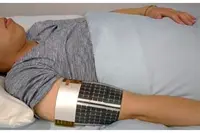Electronics News
Archive : 23 February 2015 год
 STMicroelectronics has launched the STM32L4 series of microcontrollers and is targeting the devices at energy conscious consumer, industrial, medical and metering applications.
STMicroelectronics has launched the STM32L4 series of microcontrollers and is targeting the devices at energy conscious consumer, industrial, medical and metering applications.
STMicroelectronics has launched the STM32L4 series of microcontrollers and is targeting the devices at energy conscious consumer, industrial, medical and metering applications.
The first two parts in the series – the STM32L476 and STM32L486 – feature the 80MHz ARM Cortex-M4 core with DSP and floating point unit (FPU). Combined with ST's ART Accelerator, which allows zero-wait execution from flash, the devices are said to offer a performance of up to 100DMIPS whilst consuming 100µA/MHz.
STM32L4 microcontrollers feature dynamic voltage scaling and seven power management modes, with sub-mode options. Meanwhile, ST's Batch Acquisition Mode allows data exchange with communication peripherals while in low-power mode. The parts have up to 1Mbyte of dual bank flash and 128kbyte of SRAM.
According to the company, the parts have scored 123 in the EEMBC ULPBench tests. "The ULPBench score of 123 is the best in the industry today and demonstrates that designers can now get higher performance and larger memory without trading power consumption," claimed Michel Buffa, general manager of ST's microcontroller division.
Author
Graham Pitcher
Source: www.newelectronics.co.uk
 Intel believes Moore's Law will still be valid beyond the 10nm node, but says achieving this will require new materials and device structures, as well as close collaboration between process development and product design teams.
Intel believes Moore's Law will still be valid beyond the 10nm node, but says achieving this will require new materials and device structures, as well as close collaboration between process development and product design teams.
Mark Bohr, pictured, Intel senior fellow for logic technology development, told a panel session at this week's International Solid State Circuits Conference that scaling continues to provide cheaper transistors, but added that cost reduction was still needed in order to justify new process technology.
"Innovation has always been part of the scaling process," he said in a briefing ahead of the panel session. "Technologies such as FinFETs and high K metal gate are indispensible parts of what we do."
In fact, Bohr thinks Intel can move to the 7nm node without having to resort to EUV lithography. "I'm not going to say exactly how, because our competitors watch what we do closely." However, he did say that the move would be accomplished, in part, by the use of new materials and structures. "We have published papers on III-V devices," he added, "so that's one example, but introducing any new technology will be about balancing performance against manufacturability."
Bohr also believes that 2.5 and 3D integration will also play an important role, but said it was hard to identify a point where 2.5/3D would become cost effective. But he said the techniques wouldn't be a replacement for Moore's Law. "They don't bring cost reduction, like Moore's Law, which is why they haven't become mainstream. While it adds cost, it's important to recognise the need for heterogeneous integration."
Author
Graham Pitcher
Source: www.newelectronics.co.uk
 University of Tokyo researchers have developed a 'fever alarm armband'. The flexible, self powered device, which sounds an alarm in case of high body temperature, is amongst new technologies being presented at the this year's International Solid State Circuits Conference.
University of Tokyo researchers have developed a 'fever alarm armband'. The flexible, self powered device, which sounds an alarm in case of high body temperature, is amongst new technologies being presented at the this year's International Solid State Circuits Conference.
University of Tokyo researchers have developed a 'fever alarm armband'. The flexible, self powered device, which sounds an alarm in case of high body temperature, is amongst new technologies being presented at the this year's International Solid State Circuits Conference.
The device combines a flexible amorphous silicon solar panel, piezoelectric speaker, temperature sensor and power supply circuit created with organic components in a wearable package.
According to the team, the armband incorporates several firsts, such as the first organic circuit to produce a sound output and the first to incorporate an organic power supply.
The armband – 30cm long and 18cm wide – was developed by research groups led by Professor Takayasu Sakurai at the Institute of Industrial Science and Professor Takao Someya at the Graduate School of Engineering. Prof Someya said: "Our fever alarm armband demonstrates that it is possible to produce flexible, disposable devices that can greatly enhance the amount of information available to carers in healthcare settings.
"We have demonstrated the technology with a temperature sensor and fever alarm, but the system could also be adapted to provide audible feedback on body temperature, or combined with other sensors to register wetness, pressure or heart rate."
Author
Graham Pitcher
Source: www.newelectronics.co.uk

